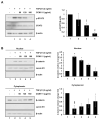CCM111 prevents hepatic fibrosis via cooperative inhibition of TGF-β, Wnt and STAT3 signaling pathways
- PMID: 30648571
- PMCID: PMC9298635
- DOI: 10.1016/j.jfda.2018.09.008
CCM111 prevents hepatic fibrosis via cooperative inhibition of TGF-β, Wnt and STAT3 signaling pathways
Abstract
CCM111 is an aqueous extract of Antrodia cinnamomea (AC) that has exhibited anti-liver fibrosis functions. However, the detailed mechanisms of AC action against liver fibrosis have not been elucidated yet. The present research showed that CCM111 significantly lowered the levels of the hepatic enzyme markers glutamate oxaloacetate transaminase (GOT) and glutamic pyruvic transaminase (GPT), prevented liver damage and collagen deposition, and downregulated TGF-β/Smad signaling in a dose-dependent manner compared with CCl4 treatment alone. CCM111 markedly inhibited TGF-β, Wnt and STAT3 signaling pathway-regulated downstream genes in the liver by next-generation sequencing. The antifibrotic mechanisms of CCM111 were further demonstrated in HSC-T6 cells. Our data demonstrated for the first time that CCM111 can protect against CCl4-induced liver fibrosis by the cooperative inhibition of TGF-β-, Wnt- and STAT3-dependent proinflammatory and profibrotic mediators, suggesting that CCM111 might be a candidate for preventing and treating chronic fibrotic liver diseases.
Keywords: Antrodia cinnamomea; Liver fibrosis; STAT3 pathway; TGF-β pathway; Wnt pathway.
Copyright © 2018. Published by Elsevier Taiwan LLC.
Conflict of interest statement
The authors have declared no conflicts of interest.
Figures






Similar articles
-
CCM111, the water extract of Antrodia cinnamomea, regulates immune-related activity through STAT3 and NF-κB pathways.Sci Rep. 2017 Jul 7;7(1):4862. doi: 10.1038/s41598-017-05072-y. Sci Rep. 2017. PMID: 28687744 Free PMC article.
-
Liuweiwuling tablets attenuate BDL-induced hepatic fibrosis via modulation of TGF-β/Smad and NF-κB signaling pathways.J Ethnopharmacol. 2018 Jan 10;210:232-241. doi: 10.1016/j.jep.2017.08.029. Epub 2017 Aug 31. J Ethnopharmacol. 2018. PMID: 28864168
-
Physalin D attenuates hepatic stellate cell activation and liver fibrosis by blocking TGF-β/Smad and YAP signaling.Phytomedicine. 2020 Nov;78:153294. doi: 10.1016/j.phymed.2020.153294. Epub 2020 Jul 28. Phytomedicine. 2020. PMID: 32771890
-
Asiatic acid inhibits liver fibrosis by blocking TGF-beta/Smad signaling in vivo and in vitro.PLoS One. 2012;7(2):e31350. doi: 10.1371/journal.pone.0031350. Epub 2012 Feb 7. PLoS One. 2012. PMID: 22363627 Free PMC article.
-
Administration of Steamed and Freeze-Dried Mature Silkworm Larval Powder Prevents Hepatic Fibrosis and Hepatocellular Carcinogenesis by Blocking TGF-β/STAT3 Signaling Cascades in Rats.Cells. 2020 Feb 28;9(3):568. doi: 10.3390/cells9030568. Cells. 2020. PMID: 32121064 Free PMC article.
Cited by
-
Lycorine Ameliorates Thioacetamide-Induced Hepatic Fibrosis in Rats: Emphasis on Antioxidant, Anti-Inflammatory, and STAT3 Inhibition Effects.Pharmaceuticals (Basel). 2022 Mar 18;15(3):369. doi: 10.3390/ph15030369. Pharmaceuticals (Basel). 2022. PMID: 35337166 Free PMC article.
-
Antioxidant therapy against TGF-β/SMAD pathway involved in organ fibrosis.J Cell Mol Med. 2024 Jan;28(2):e18052. doi: 10.1111/jcmm.18052. Epub 2023 Dec 2. J Cell Mol Med. 2024. PMID: 38041559 Free PMC article. Review.
-
Lipophilic Constituents in Salvia miltiorrhiza Inhibit Activation of the Hepatic Stellate Cells by Suppressing the JAK1/STAT3 Signaling Pathway: A Network Pharmacology Study and Experimental Validation.Front Pharmacol. 2022 Apr 20;13:770344. doi: 10.3389/fphar.2022.770344. eCollection 2022. Front Pharmacol. 2022. PMID: 35517817 Free PMC article.
-
Daucosterol Alleviates Alcohol-Induced Hepatic Injury and Inflammation through P38/NF-κB/NLRP3 Inflammasome Pathway.Nutrients. 2023 Jan 1;15(1):223. doi: 10.3390/nu15010223. Nutrients. 2023. PMID: 36615880 Free PMC article.
-
Target identification of hepatic fibrosis using Pien Tze Huang based on mRNA and lncRNA.Sci Rep. 2021 Aug 20;11(1):16980. doi: 10.1038/s41598-021-96459-5. Sci Rep. 2021. PMID: 34417500 Free PMC article.
References
-
- Hellerbrand C. Hepatic stellate cells – the pericytes in the liver. Pflugers Arch. 2013;465:775–8. - PubMed
-
- Tsuchida T, Friedman SL. Mechanisms of hepatic stellate cell activation. Nat Rev Gastroenterol Hepatol. 2017;14:397–411. - PubMed
-
- Meng XM, Nikolic-Paterson DJ, Lan HY. TGF-beta: the master regulator of fibrosis. Nat Rev Nephrol. 2016;12:325–38. - PubMed
Publication types
MeSH terms
Substances
LinkOut - more resources
Full Text Sources
Medical
Miscellaneous
